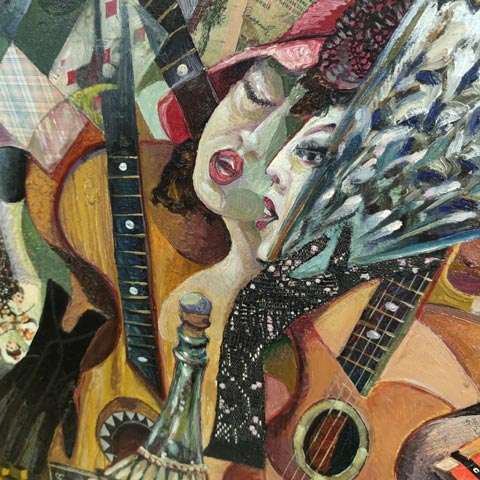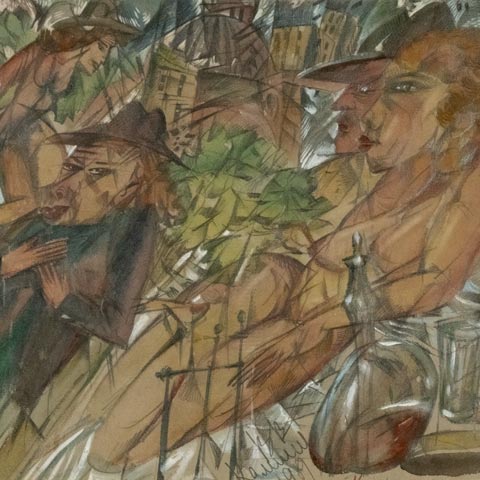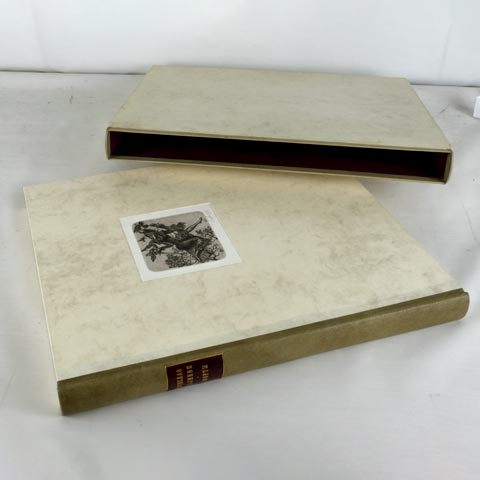
Calligraphic sign “Kalinin VV” — the signature of Vyacheslav Vasilievich Kalinin (1939) — is a valuable attribute for his paintings, but not a necessary one. It is impossible not to recognize, and even more so to confuse Kalinin with someone. Original, distinctive organic style of the artist has not changed since the early 1960s. Cubist chopped outlines, tracing the movement of figures and turns of faces, dense narrative plot — all this fills his paintings for more than sixty years. Kalinin himself has more than once admitted that all his life he paints his autobiography on canvases. In his paintings there is no empty space. He wants to tell everything, to fill everything. To contain as many stories from his past as possible. About his childhood among the outlaws of Zamoskvorechye. About fights and debauches in the nooks and crannies of postwar Moscow. About drinking buddies, the bohemians and vagrants, broken girls and drunken nights out after hard work. At the same time, Kalinin's stories are not gloomy, and even less so “black”. Revelry and merriment reigns there. No wonder his style was called “carnivalism”. There is no hypocritical morality in Kalinin's paintings. This is an important point. The artist amazes not only with his sincerity, but also with the absence of pathos, typical for many established colleagues. You will not hear from him pompous discourses about the search for meaning in the 1960s. «Life went on as usual: work and drinking.» Captivatingly simple and honest.characteristic of many accomplished colleagues. You will not hear from him grandiloquent discourses about the search for meaning in the 1960s. «Life went on as usual: work and drinking.» Captivatingly simple and honest.characteristic of many accomplished colleagues. You will not hear from him pompous discourses about the search for meaning in the 1960s. “Life went on as usual: work and booze.” Captivatingly simple and honest.
The Soviet authorities did not like Kalinin at once. Unconscientious element. After the first presentation of Kalinin's paintings to the court of the Moscow Union of Artists in 1961, the artist was decided to be expelled from Abramtsevo school. And it cost a lot of effort to restore, complete and finish with honors. His first exhibition at the Kurchatov Institute lasted two days, until it was closed on the signal of vigilant citizens. In the 1960s, the fateful meeting of the young artist with the Lianozovites Kropivnitsky and Rabin took place. An accidental trip for the company of friends grew into many years of valuable communication in the circle of like-minded people.
Like the majority of artists of unofficial art, Kalinin was forced to work in the desk. There were virtually no opportunities to exhibit. During the day he earned a living decorating clubs, and in the evenings and weekends, he painted for the soul. Paintings were bought rarely. There were sales to the Stevens family and other foreign buyers. There was a small circle of collectors among his own. At the Bulldozer exhibition in 1974 Kalinin went without paintings. But in 1975, he was among the participants of the exhibition of independent artists in the pavilion “Beekeeping”, which was a breakthrough for unofficial art and the first meeting with the general public. In 1976, a reservation for “avant-garde” artists was opened, the “city committee” hall at 28, Malaya Gruzinskaya Street. Kalinin was among the regular participants of the exhibitions — as part of the “seven”, “twenty” and other groups. The city committee ended at the turn of the 1990s. Soon Kalinin left to the USA at the invitation of local galleries, and for many years he lived in two countries: in the summer — in Russia, in his favorite Priluki next door to his friend Nemukhin, and in the winter — in the States. America did not affect the nature of creativity — the heroes of Kalinin's paintings remained Russian bums, bustling maidens, and artists — friends of youth.
What about the prices? The records of the fat times — $ 80,000–112,000 — at the auctions in London in 2007–2008 can only be recalled as a historical fact at the peak of the Russian market. But in general, the real price levels for top-class works are quite impressive today. Canvases larger than one meter in size are now sold on the auction market in the range of $ 15,000–20,000. And if you buy with an investment in mind, then it is worth paying attention to them.
In general, collectors and investors can be guided by the following prices (in descending order of investment attractiveness):
- Paintings from one meter in size and up — the range is $ 15,000–20,000 (1,125,000–1,500,000 rubles). I repeat — this is the most promising segment for investment. Prices for high-end works of art usually not only grow faster in value, but they are also more liquid. In practice, they are easier and quicker to be sold than mid-range paintings and drawings.

- Paintings of 50–100 cm in size are now sold in the $ 5,000–7,000 range (375,000–525,000 rubles). Here, too, there are no problems with liquidity and there is potential for price growth.

- Color drawings — $ 2,000–3,000 (150 000–225 000 rubles). In terms of emotional charge and the density of the plot, Kalinin’s graphics is often not inferior to his painting. But paper is paper — other things being equal, painting is growing in price faster. Kalinin's black-and-white drawings are much cheaper. They can be bought in the area of 50,000 rubles.

- Circulation graphics — 30,000 rubles, albums with etchings — 150,000 rubles. These are for the soul, for home and office decoration. In the case of albums, they are suitable for cautious display in the circle of connoisseurs and collectors. Prints are poorly suited for investment. This is less true for albums of etchings, which are published with stunning quality. They are already a rarity, and their price will rise.


What about the investment prospects? At levels of $ 15,000–20,000, it's hard to say that the artist is undervalued. No, this is a balanced market situation. That is, under these conditions, we can talk about the normal growth potential of the order of 15–20% a year. Or faster, if economic growth accelerates. Once again, the most high-class and therefore the most expensive works can grow faster. So first of all we advise to pay attention to paintings in the meter to meter and a half size. There is no need to be strongly attached to the year of creation, because in the case of Kalinin there is no such pronounced periodicity. He did not have a dramatic change in style, so he is extremely recognizable both in his 1970s and in his 2010s. It is better to choose according to the energy of the work, according to the dashing plot, according to the painstaking technical execution. This is more important overall.
What is the situation with counterfeits? Kalinin is not yet included in the risk group. Fakes are rare. But, as with all works by artists of the sixties, the usual precautions must be observed with his works. The authenticity is confirmed by the artist himself. And, in addition, Kalinin's works are well supported by literature. Many of his works have been published in numerous catalogues and included in the visual range of films about the artist. Collectors will have a place to roam. And this information openness is another important factor for ensuring a favorable investment climate.
Vladimir Bogdanov, specialist of ArtSale.info auction
Watch also a video review on investing in the works of Vyacheslav Kalinin on our YouTube channel:
- Log in to post comments










